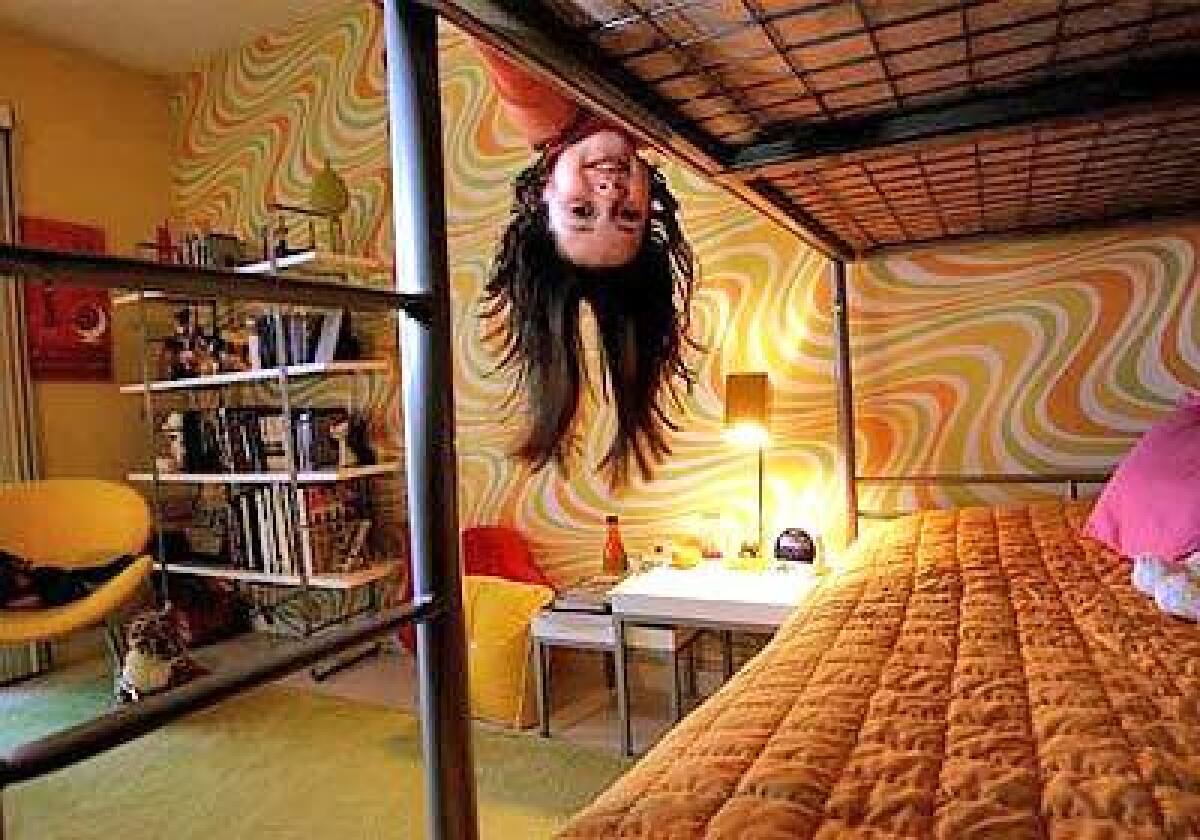It’s cool, really

America, get ready to unroll. Led by a number of old British design houses such as Farrow & Ball, which last year opened a retail store on Melrose Avenue, wallpaper is staging a comeback.
It’s no longer just paper printed with English roses, either. Thanks to 21st century ingenuity, the array of wall coverings is dizzying: hand-painted fabrics, paper-backed woven fibers known as grass cloth and scrub brush-proof vinyl that simulates quilted leather. Hoping to romance a new generation of home decorators, the British firm Graham & Brown has launched “Frames,” a black-and-white paper ($19.99 a roll) that kids can use as a wall-size coloring book.
There are papers, it seems, for every demographic: glitter-bedecked Pucci-esque swirls for prepubescent princesses, metallic papers with velvety flocking for Hollywood hipsters and custom designs by L.A. architect Barbara Bestor for die-hard modernists.
“It’s instant art, available to everyone for as little as $20 a roll,” says Amanda Masters, who, like local designers Michael Smith and Greg Jordan, has become a paper pusher.
Tricky to apply and only slightly less tedious to remove, wallpaper seems to have been invented for an episode of “I Love Lucy.” It is, however, becoming user-friendly. Mass-market manufacturer Carey Lind introduced a collection called Easy 2. It allows users to paste the wall instead of the paper, which later peels off in full strips without residue or surface damage. Even so, Masters suggests consulting a professional.
“Doing it yourself can be a disaster,” she says. “Paperhangers can put it up in a day without having to move furniture and put dropcloths everywhere, so you get instant gratification.”
Wallpaper also provides instant personality. Can’t afford wood paneling? Try Maya Romanoff’s wood veneer with paper backing, available at Donghia, or the Nobilis faux bois, available through Kneedler Fauchère, both in the Pacific Design Center. For a witty twist on tradition, the PDC’s Hinson showroom has a collection by Studio Printworks that includes “Spying on China,” a toile landscape overrun with U.S. airplanes.
“I like an instant punch,” adds the British-born Masters, who confesses a fondness for Cole & Son, which carries prints by swinging ‘60s London designer David Hicks. “If there’s a room looking a little sad, dark or small, for a few hundred dollars you can turn it into a jewel.”
Jonathan Adler decked the halls of the Parker Palm Springs hotel in a textured white pattern that resembles ornate pressed tin ceilings. “I use wallpaper constantly,” he says. “I think walls are an underappreciated asset, and, frankly, paint is starting to look boring.”
“Wallpaper has been deeply unfashionable for decades,” says Tom Helme, creative director of Farrow & Ball. “For a couple of years now, design magazines have been saying wallpaper is back, but it is only now translating into sales.”
The former decorations advisor to Britain’s National Trust, the largest custodian of period property in the world, Helme revived the old-fashioned technique of woodblock printing with paint on paper “as a service to the restoration community.” In the mid-’90s, Farrow & Ball added updated versions of these historic wallpapers to its paint business, and, says Helme, “sales have doubled every year, with half our wallpaper production shipped to the United States.”
Many exports go to the East Coast, where striped and damask papers add an heirloom quality to older homes. In California, grass cloth, all the rage 50 years ago, is the most requested product at Jeffrey Stevens, a Pacific Design Center showroom with more than 100 wallpaper collections. In California, says owner Sheldon Abrams, textured coverings give a midcentury beach house look and also work better on the rounded walls common in new construction.
“Grass cloth is wonderful because it’s a neutral that gives richness to the surface and can serve as a background to boldly patterned furniture and accessories,” says Adler, who used it on the ceilings of guest rooms at the Parker. “I love to wallpaper a ceiling. It adds an improbable layer of luxury to a room.”
*
(BEGIN TEXT OF INFOBOX)
Oh, go ahead
Tips for people considering wallpaper in their homes:
Pick your spots: “Entryways, powder rooms, dining rooms, guest rooms and libraries are great,” Masters says. “Don’t wallpaper your sauna, laundry room or anywhere damp.”
Use color and pattern: “It’s very fashionable at the moment to go for bold hues and big prints in home décor,” Masters says. “Instead of reupholstering a $5,000 sofa in orange and getting sick of it, keep the furniture neutral and go a little bit wild on the walls.”
Check the scale: “The taller the wall, the bigger the print can be,” says Tom Helme, creative director at wallpaper manufacturer Farrow & Ball.
Know which prints work: Some are charming, others alarming. “Vertical stripes add height to a low-ceilinged room,” Masters says. “A small room can carry a very bold print or complicated pattern, which can cover an imperfect wall. Reflective wallpaper enlarges a room, but not on every wall — that can be a little overpowering.”
Try one wall: “People are using wallpapers as an accent, for a dramatic effect,” Helme says. “A bolder pattern or a stronger color on just one wall is the best way to achieve it.”
Buy extra: “You have to buy more paper if you have a big pattern in order for things to match, and wallpaper can’t be touched up,” Masters says. “It’s good to have a spare roll or two. You can always use it for wrapping paper or shelf liners.”
Don’t worry about resale value: “If your house looks smart and pulled together,” Masters says, “people will fall in love with the wallpaper.”
For more information or to see a range of designs, call Graham & Brown at (800) 554-0887 or go to https://www.secondhandrose.com , https://www.farrowandball.com and https://www.studioprintworks.com .
— David A. Keeps



